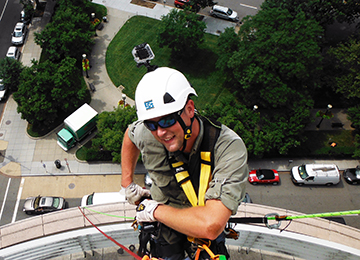Every few months we seem to hear on the news about a window washer being rescued from a building or a contractor being saved by their equipment. Window cleaning, along with façade maintenance and façade inspections, is an industry assumed to be hazardous because it ‘looks dangerous’ to rappel in an urban environment. While it does require care, focus and attention to safety requirements, and the few newsworthy accidents will make headlines, it is, in fact, a relatively safe working environment when the proper precautions are taken.
Façade access for general industry is regulated by the United States Department of Labor Occupational Safety and Health Administration (OSHA). On November 17, 2016, OSHA issued a final rule with respect to Walking-Working Surfaces and Personal Protective Equipment (Fall Protection Systems). The final rule provides revisions and new provisions to the general industry Walking-Working Surfaces and Powered Platforms for Building Maintenance standards included under OSHA 29 CFR part 1910 standards. The final rule became effective on January 17, 2017 with select compliance dates after the effective date.
Included under the final rule are revisions and new provisions specific to Owner requirements with respect to rope descent system (RDS) façade access to the building. The Owner requirements for RDS façade access include:
- Provide permanent anchors for safe access to the building’s vertical façade
- Separate, individual anchors must be provided for the rope descent system user’s suspension and fall arrest lines to access each area
- Each anchor must be:
- Capable of supporting at least 5,000 pounds in any direction, for each worker attached;
- Annually inspected by a qualified person; and
- Load tested and certified by a qualified person:
- prior to initial use;
- as needed*;
- and at least every 10 years
*Instances for which load test re-certification of anchors may be required prior to the 10 year interval include but are not limited to: exposure to a fall arrest incident, damage to the anchorage, major alterations to the building, exposure to destructive industrial substances, and exposure to high rainfall or exposure to sea air and humidity that might accelerate corrosion.
Please note that Rope Descent Systems may not be used at heights greater than 300 feet. For heights greater than 300 feet, alternative façade access methods such as Industrial Rope Access System (IRAS), suspended scaffolding or other powered platform systems may be utilized in accordance with applicable OSHA standards.
Contact us for more information about fall protection and suspended access, or should you have a project that requires fall protection anchor or suspended scaffolding davit load testing, inspection and design services.

